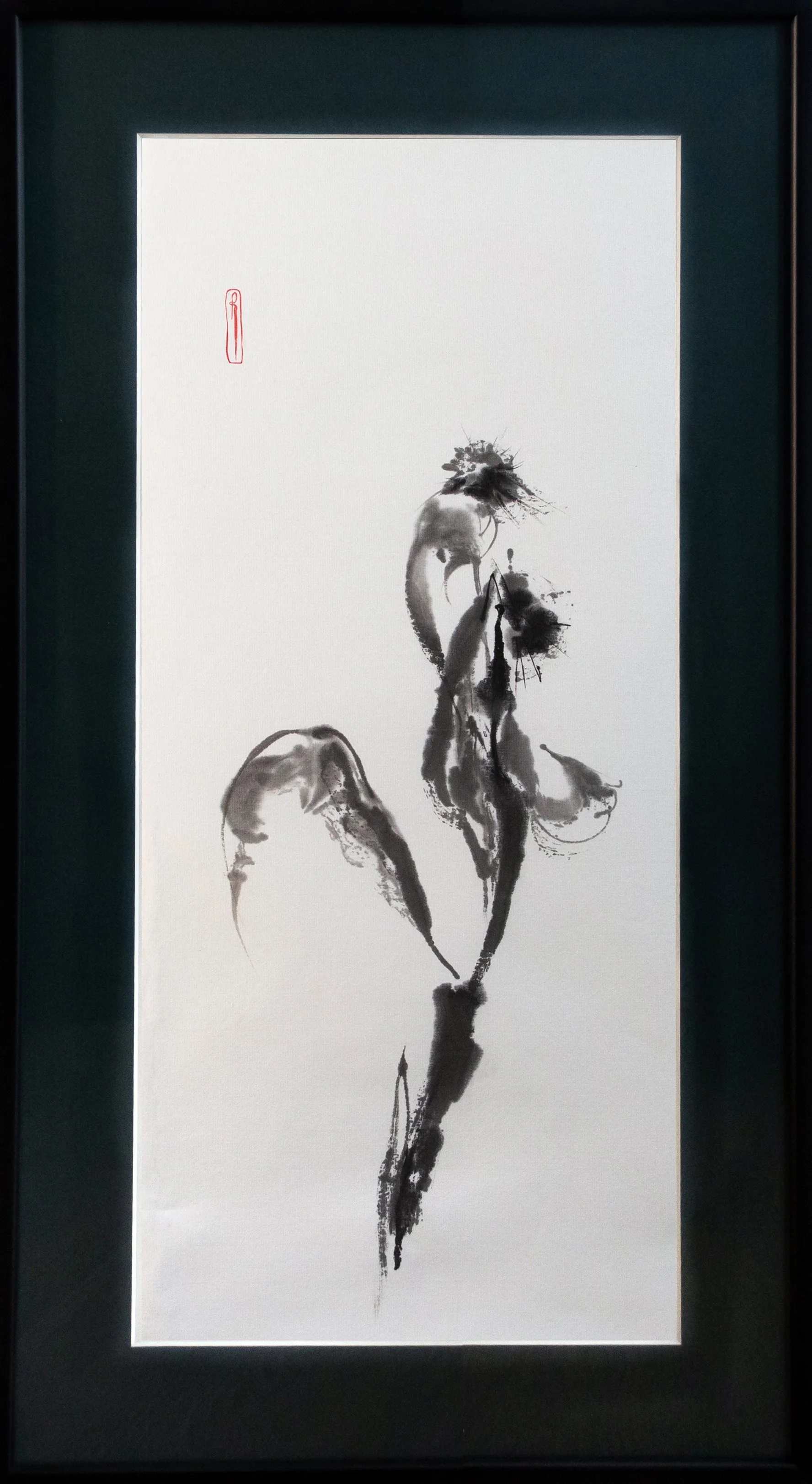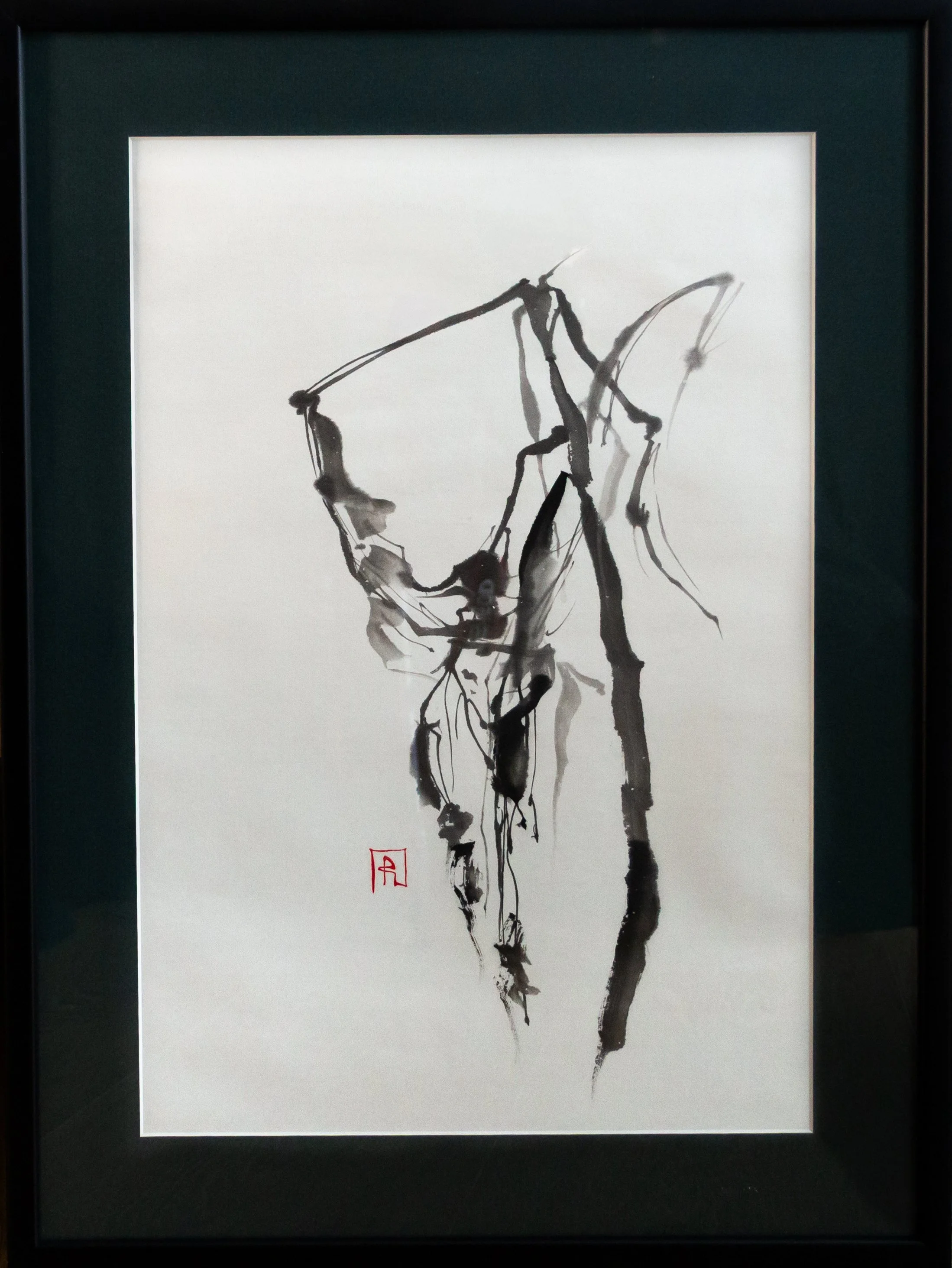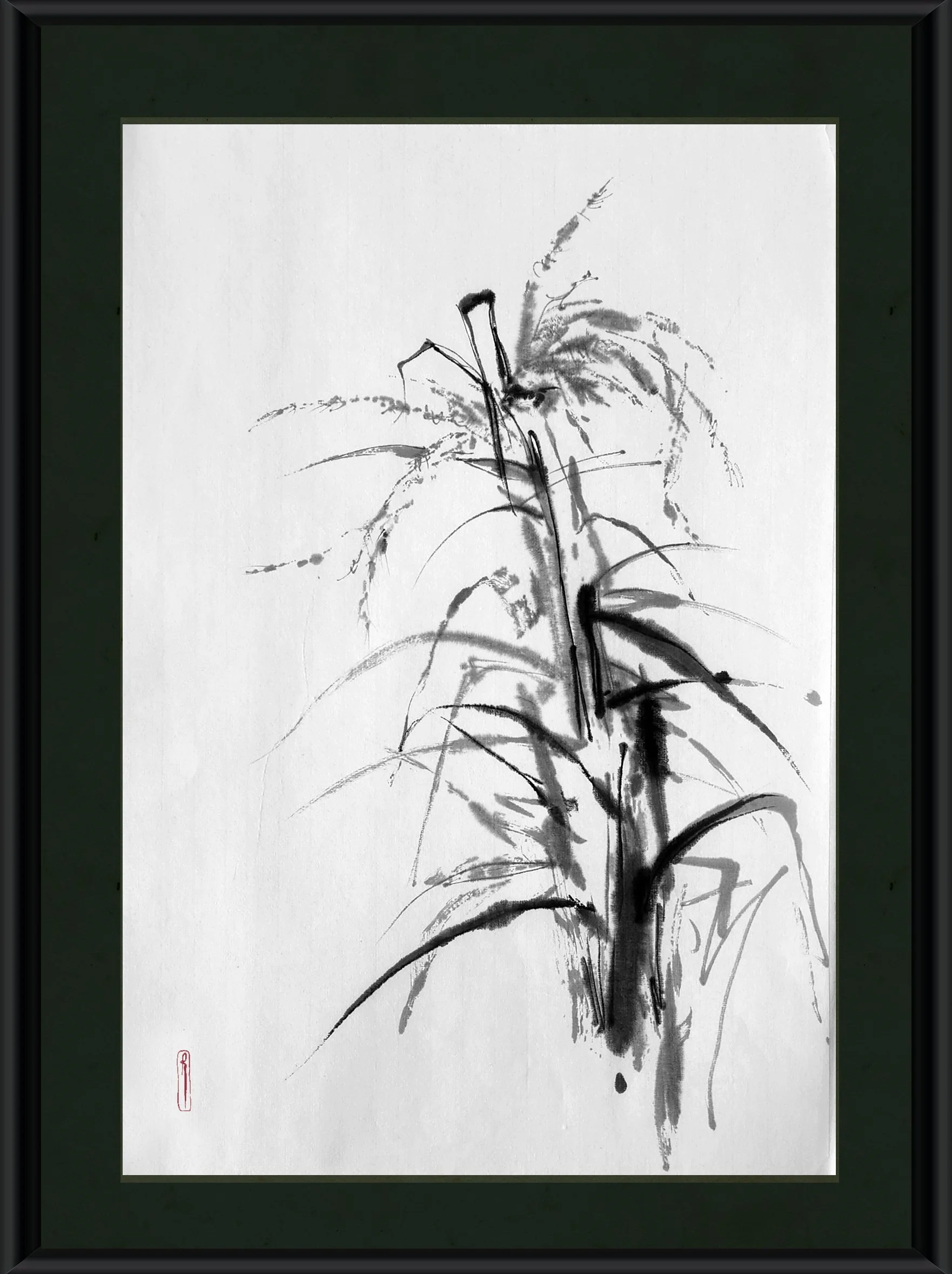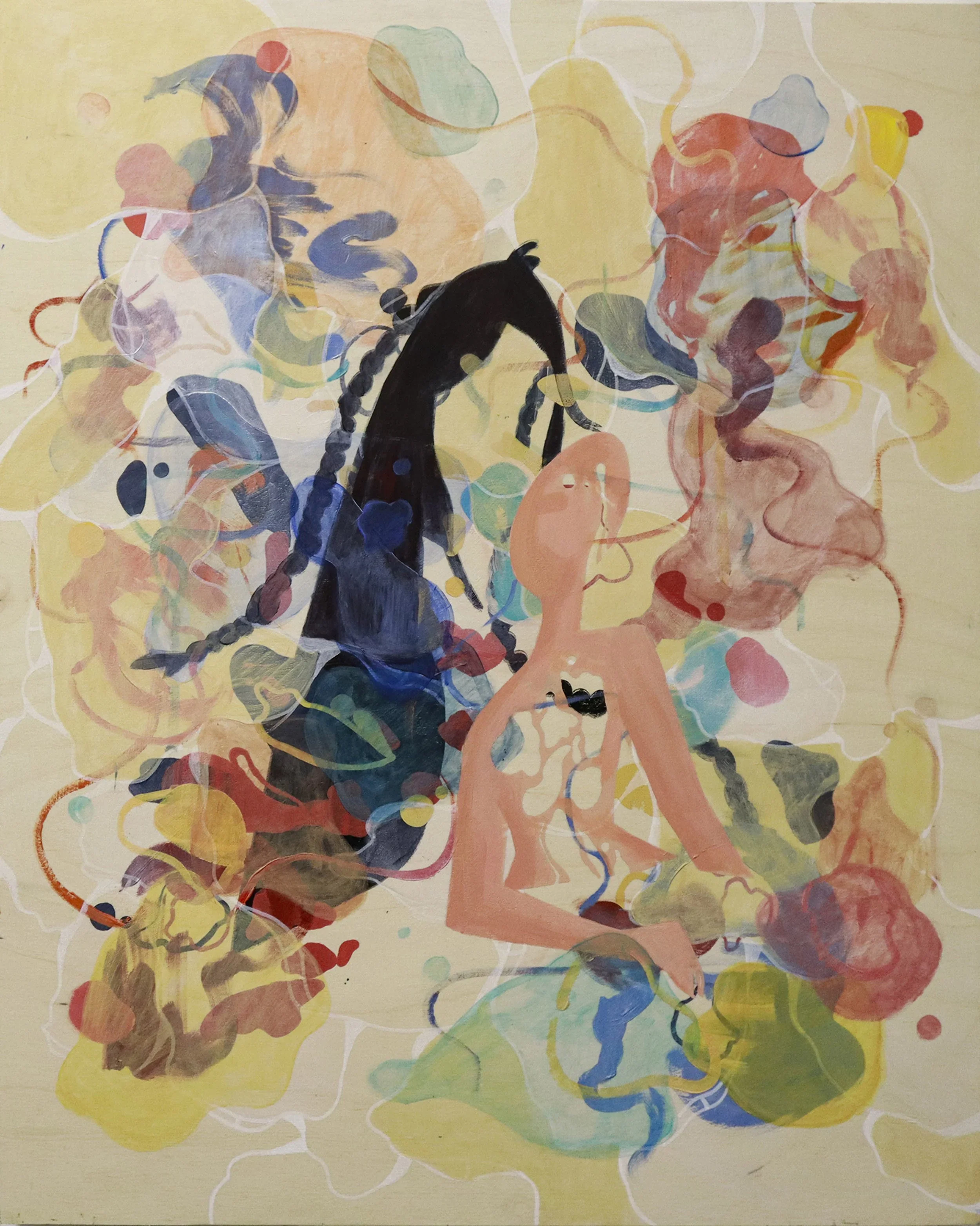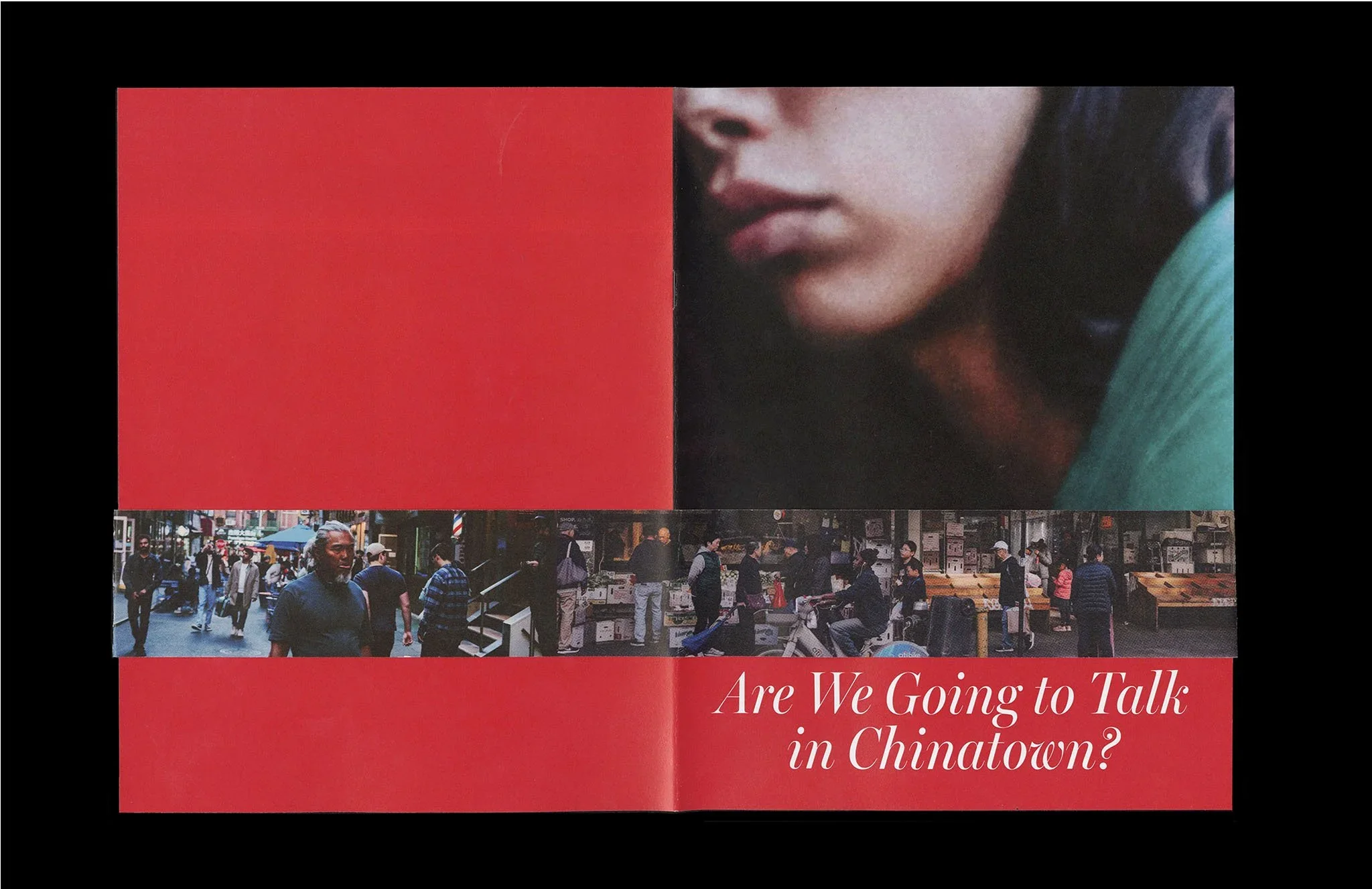10 Questions with Anna Kirsanova
Nature is ever-changing, concise, and expressive. Its dynamics unfold through subtle movements, sometimes unpretentious, almost elusive, yet always capable of capturing attention. This fluidity of nature serves as the foundation for Anna Kirsanova’s artistic exploration. At the core of her work lies the theme of contemplation. She invites the viewer to look and truly see, emphasising that beauty is found in the eye of the beholder. Her art highlights the aesthetics of nuance and the simplicity of nature, encouraging appreciation for the small, seemingly insignificant details, a blade of grass, the curve of a trunk, or the tension within a plant’s form. Through her work, she seeks to revive the disappearing experience of mindful observation in a world consumed by modern distractions.
Nuance is central to both her compositions and use of transparent tones. Utilising ink and traditional Chinese brushes, she captures the spontaneity and fluidity of movement. The free brushstrokes allow her to convey the essence of plants without rigid contours, focusing instead on their dynamic transformations under environmental pressures. The black-and-white palette removes distractions, drawing attention to composition and
movement. Precision plays a key role in her work, ensuring that each line and gesture contributes to the overall expression. Her work portrays individual episodes from the life of plants, depicting their deformations under external pressures. The rhythmic, pulsating nature of her graphics reflects the organic fluctuations within nature. Just as a thorn differs from a burdock, each plant demands a unique artistic approach. Despite their meditative calm, her compositions remain vibrant and full of life.
Anna Kirsanova - Portrait
Anna draws deep inspiration from Chinese painting, particularly the Se-yi style and the works of Qin Tianzhu, Pan Gongkai, and Shi Lu. She admires their seemingly careless yet highly expressive strokes, which breathe life into each piece. These influences have significantly shaped her approach, guiding her toward a style that values spontaneity and emotional depth. For Anna, painting offers a fresh perspective on the world. It allows her to see with greater clarity and luminosity, evoking a warmth that is both physical and metaphorical. This artistic process generates a profound sense of harmony, emerging spontaneously like a melody. Her creative visions take shape during walks through forests and fields, where nature fuels an internal need to translate fleeting moments onto paper.
Music plays a vital role in her artistic practice. She always listens to Chinese folk music while painting, as its slow yet sudden transitions mirror the rhythmic flow of ink. The interplay of movement and stillness in the music enhances her ability to capture the energy of her subjects, making sound an essential element of her creative process. Though deeply influenced by Chinese painting, Anna does not seek to replicate it. Instead, she embraces its bold spirit, its sense of fearless exploration and willingness to accept imperfection. Her work celebrates the idea that beauty lies in flaws, and true artistic freedom comes from focusing on essence rather than strict representation. By refining her own approach, she has cultivated a style that prioritises expressive lines and the essence of the subject.
The technical process behind her work is intricate and essential. She employs traditional Chinese ink painting tools, including calligraphic brushes, water-resistant ink, and rice paper. These materials interact dynamically, shaping the outcome of each piece. Once a painting is completed, it undergoes a meticulous finishing process, stretching, gluing, and sealing, before it is truly considered finished. Each work carries its own distinct texture and presence, reflecting the unique journey of its creation.
Her artistic journey has been shaped by both education and experience. Anna earned a Bachelor of Architecture from the University of Architecture and Civil Engineering in Samara, Russia, in 2014. She later moved to Brno, Czech Republic, where she completed her Master of Architecture at the Czech Technical University in 2017. While her formal education provided a foundation in artistic principles, it was a transformative trip to China that deeply influenced her creative path. Years after absorbing this experience, she integrated it into her art.
In terms of exhibitions, she held a solo exhibition in January 2025 at the Platinum Gallery in Brno and in June 2025 at the Vinná Galerie in Brno. In June 2025, she was also selected for the ArtBias Budapest Golden Duck publication for the Visual Art Journal issue 25. Lastly, in October 2025, she was selected for the Cromer Open.
Clematis vitalba, ink, 31x55 cm, 2025 © Anna Kirsanova
INTERVIEW
You originally studied architecture before transitioning fully into art. How has your architectural background influenced your artistic vision and practice?
My journey as an architect continues, focusing on the design of public buildings and hospitals. There’s an inseparable connection between architecture and art, that’s no secret. But first, let me explain why I sought expression through painting.
By its very nature, architecture gravitates toward regularity and rigour. It’s full of routine and constraints. It’s easy to get mired in this and lose the spark of creativity. Yet that doesn’t mean it’s the only path. Art, with its fluidity, nuance, and dynamism, offers architects a broader and freer way of seeing. It helps us create bolder, more original projects, preserve our creative energy, and infuse it into the world around us. For this reason, I believe that painting, or any other form of creative expression, is infinitely important for an architect.
This is precisely what I’ve tried to embody in my own work, free from the constraints inherent in design. My painting is a manifesto of freedom and lightness, a balance of disorder and harmony within chaos. My architectural background reveals itself in my sense of composition, rhythm, and the dynamics of form, as well as in the airiness of the pictorial space. I perceive my paintings primarily as spaces. I’m not afraid of the blank page, quite the opposite. White is one of my maintools of expression. My general love of black-and-white graphics is, I think, also an echo of my architectural education.
But architecture doesn’t only help; sometimes I even have to fight against it. My hand automatically draws straight, parallel lines, which don’t always belong in a painting. Yet this challenge is also a valuable exercise in self-control. It helps me understand what I want to create and how I should achieve it. And, of course, I bring these insights back into my architectural practice.
Callistemon, ink, 22x50 cm, 2025 © Anna Kirsanova
Lightness, ink, 32x50 cm, 2025 © Anna Kirsanova
What drew you to ink painting and traditional Chinese brushes as your primary medium?
During our trip through China, I once saw a painting in an old traditional Chinese hotel. At first glance, it seemed careless, almost shapeless, not beautiful at all. I wondered why it was there. But later, I began to notice the energy within it. That energy compelled me to look closer. Its bold, expressive strokes seemed to breathe life into every part of the work.I was astonished. Even today, I still see that painting whenever I close my eyes.
Later, I decided to experiment with this technique myself. But traditional Western tools couldn’t create the same effect; they lacked lightness and freedom, leaving little room for spontaneity. Chinese ink, brush, and paper form a unique trio that works in harmony, each element essential and each with its own role. For me, drawing is an act of balance, a subtle dialogue among these tools. They are my endless source of inspiration. Just three simple elements open up infinite possibilities for self-expression.
Nature plays a vital role in your practice. Can you describe how your walks in forests and fields shape your creative process?
I observe. During my walks, I try to keep my attention on the world around me rather than drifting inward. It’s not easy. In Western culture, there isn’t a strong tradition of meditation or contemplation. But it’s an interesting experience. One has to consciously stop, make oneself look at the world, and truly see it. It may sound obvious, but it’s far from simple. We’re used to being caught up in the rush of things. Yet the ability to notice small details, to see beauty in the ordinary, is equally important. That’s when the world begins to reveal its depth.
Of course, a beautiful landscape is the perfect setting to spark creativity, but reality is often more prosaic. I often find the subjects that interest me just around the corner, under a fence, by the roadside, in places far from poetic. Sometimes these are only fleeting images that vanish as quickly as they appear. In those moments, I hold them in my memory and later try to bring them to life on paper.
Desire, ink, 33×60 cm, 2024 © Anna Kirsanova
Your compositions focus on nuance and movement rather than strict representation. How do you balance spontaneity with precision in your work?
It’s a deeply intuitive process, and I’m actively developing this approach. Architectural design requires a rational mindset, whereas painting is a kind of elemental force, something archetypal that must be released rather than restrained. Painting is a passion; it doesn’t tolerate half measures.
To reach that state, I try to detach myself from reality while at the same time focusing intensely on the subject, letting its image pass through me to create something pure and expressive, stripped of everything unnecessary.
Spontaneity and chance play an essential role. Even when I try to control my movements and the balance of water, it’s impossible to predict how the brush and ink will behave. We are equal partners in this creative process. Yet, even if spontaneity takes a leading role, the work still demands precision, clarity, and self-mastery. These are vital for understanding, guiding, and controlling the entire act of painting. Without them, there would be no development, only chaotic stains.
My precision lies in how faithfully I can translate my vision of the subject through technique. The thrill comes from knowing I have almost no right to make a mistake. Each painting is created in a single breath.
You often listen to Chinese folk music while painting, as you mention in your statement. How does sound influence the rhythm and flow of your brushstrokes?
I’ve noticed that many branches of Chinese art are closely intertwined: painting, music, calligraphy, and poetry. They seem like different facets of the same essence. I don’t know of any other phenomenon quite like it.
Chinese music, on the one hand, is meditative and repetitive; on the other, it is impulsive and dynamic. It moves swiftly from one passage to another, then suddenly pauses, as if taking a deep breath before surging forward again, only to fall still once more. This rhythm resonates deeply with the movement of the brush.
The speed of the stroke largely determines the character of the line or mark. The slower the movement, the more water seeps onto the paper, creating a denser, heavier stain. Conversely, rapid movements produce sharp, refined lines. The interplay between the two gives the painting its rhythm and sets the tone for the entire composition.
In a way, painting for me is like a dance. When I manage to move in harmony with the melody, the process itself becomes a source of immense joy and inspiration.
Your works highlight the transformations of plants under external pressures. What fascinates you about these subtle deformations?
Plants are very different from us. They are constantly shaped by their surroundings, or rather, their movement and form are defined by environmental pressure. For them, deformation is not what it is for humans. What we might see as a symbol of tragedy is, for them, simply a way of becoming. This is something I try to emphasise in my work. Their destiny is not our own, and there is no need to project human experience onto their existence.
Here lies another fundamental distinction between Eastern and Western worldviews. We, in the West, are deeply anthropocentric. For us, the human being is the measure of all things. But sometimes it’s useful to think differently, to try to understand another form of life.
Returning to the plants themselves, I love observing the subtlest movements of their stems. There is beauty in that. Nature doesn’t seek drama. Within it, everything coexists, even the nearly straight and parallel lines. Capturing this movement, which remains alive and imperfect despite its regularity, is a true challenge for me.
Trace of autumn, ink, 31x45 cm, 2023 © Anna Kirsanova
Continuousness, ink, 30x54 cm, 2023 © Anna Kirsanova
Sheaf, ink, 32x52 cm, 2025 © Anna Kirsanova
Torn, ink, 31×51 cm, 2025 © Anna Kirsanova
You draw inspiration from Chinese painters like Qin Tianzhu and Pan Gongkai. In what ways do you reinterpret these influences to create something uniquely your own?
What I value most is the spirit of their art. They were never afraid of imperfection. I would even say their paintings are more spontaneous and dynamic than the plants themselves in nature. Their lines are bold and full of energy; their brushstrokes are both precise and careless at once. They capture the essence of the subject without lingering on details, cutting away everything unnecessary. This is what I aspire to achieve in my own work.
Yet, despite my admiration for these masters, I don’t aim to imitate them. I strive to develop my own style, approaching each plant individually, each one that sparks my curiosity. I work without clichés. There are only different techniques, and each time I try to invent something new. It’s impossible to use the same approach when painting a burdock leaf and an inflorescence.
Overall, I aim for greater abstraction while preserving the distinctive character of each plant, so that the viewer can still recognise familiar forms within the work.
Contemplation seems central to your work. How do you hope viewers engage with your pieces on a mindful level?
Art is inherently ambiguous, and that is where its true value lies. We perceive paintings through the prism of our own personality, emotional state, life experience, and education. There’s no escaping that. I’m against any single, fixed interpretation of a painting; that would be dull and would deprive people of the wonderful process of self-discovery through art.
It’s a form of personal growth to pause and wonder what compelled the artist to spend time and energy depicting a simple blade of grass. One viewer might see only the beauty of the brushwork, the movement of ink, with the subject serving merely as a pretext to demonstrate technique. Another might find a reflection of life’s drama. Yet another may suddenly realise that even the most seemingly insignificant forms of life are worthy of attention.
If I were to define my vision, I would say that I hope my works evoke the same sense of wonder I once felt in that old Chinese hotel, the moment I realised that beauty could exist even there. I want the viewer to feel the lightness in my brushstrokes and the freedom they carry.
Ultimately, the purpose of my work is to express liberation from habitual thinking, from conventional ideas of beauty, from popular themes.
From the deep, ink, 34x69 cm, 2025 © Anna Kirsanova
With several upcoming exhibitions this year, what themes or works will you be presenting, and how do you envision their reception?
This year, I am presenting a large series of works titled “Shadows of Winter”, on which I have been working for quite some time. The series brings together my observations of plants during late autumn and winter, their interaction with nature, with snow, wind, and harsh weather. It is a restrained series, dominated by delicate, lace-like lines and calm, muted tones.
The message I wish to convey through this series can be expressed as follows: autumn and winter are seasons of reflection and contemplation, a time of stillness and quiet wisdom. Bare landscapes may seem desolate, yet they conceal an unexpected beauty: the strangely deformed leaves, the lacework of dry stems, and the countless shapes of seeds. It is nature suspended in time, gathering strength to bloom again in spring.
Autumn is my favourite season. I hope that the viewer will also feel this quiet pleasure while contemplating my paintings.
Looking ahead, what are your main artistic goals and projects you hope to develop in the next few years?
I am currently working on several series of paintings, united primarily by their technical approach. One that particularly fascinates me is the series “Line. Stain”, in which I aim to combine works dominated by linear drawing with those based on the expressive power of the stain. These are two opposing approaches, two different worlds, that I want to bring into dialogue.
The linear drawing is concise and expressive; there is no room for error, every stroke must fall precisely in its place. The stain, on the other hand, is a strong compositional element, voluminous and textured. It draws attention but also demands technical precision.
They are different, yet share a common spirit of impressionistic observation. Some plants call for a minimalist, linear depiction; their movements are expressive and dynamic. Others reveal their beauty through flat, textural elements and an active filling of the page.
This dialogue between line and stain may become a fascinating experiment, two facets of a single reality, both accessible to human perception.
Artist’s Talk
Al-Tiba9 Interviews is a promotional platform for artists to articulate their vision and engage them with our diverse readership through a published art dialogue. The artists are interviewed by Mohamed Benhadj, the founder & curator of Al-Tiba9, to highlight their artistic careers and introduce them to the international contemporary art scene across our vast network of museums, galleries, art professionals, art dealers, collectors, and art lovers across the globe.





